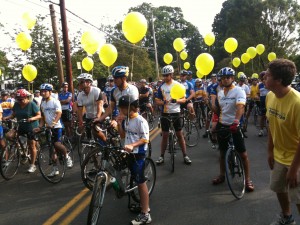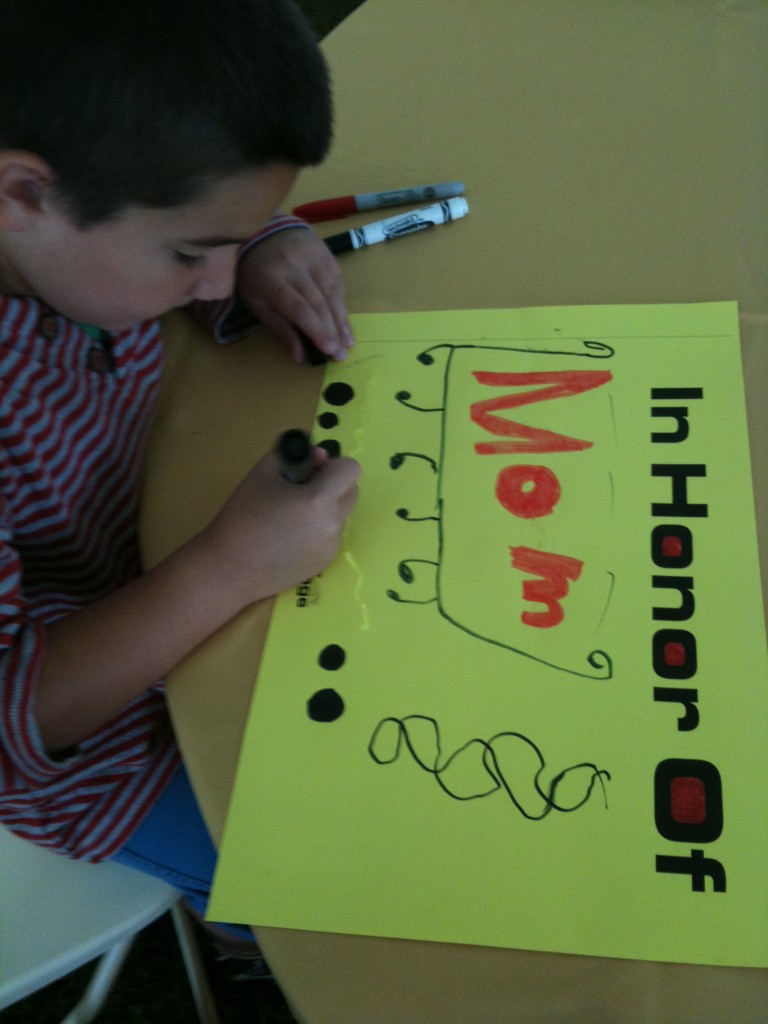The riders lined up along the narrow street, more of them this year than last. The streets were still damp. At the first corner of the course, a large puddle remained from the previous night’s storm. Volunteers handed out yellow balloons to cancer survivors; the balloons danced and tugged at their strings, waiting for release.
The cyclists waited along the street, some joking, some quiet. Some looked up at their balloons, remembering. Some looked at the backs of the jerseys of their fellow riders, mentally noting how many survivors there were among them. As the announcer droned on about the course, ensuring that the 75 and 100 mile riders had maps, we all breathed deep breaths, psyching ourselves for some of the emotional moments about to occur.
An 11 year-old girl sweetly and strongly sang the National Anthem. Then the announcement came to release the balloons. The announcer said this bike event was for us, that it was in our names the riders were going. We let the balloons go and watched as they floated into the sky. Everyone clapped, some tears were shed. If only we could erase the pain that we’d had as easily.
And then it was time for the Survivor’s Lap of Honor. Any cancer survivor who is riding in the Connecticut Challenge takes an honorary lap around the starting area to be recognized before the official start of the event. Some of the cyclists are riding during treatment, some of them during chemo. How they get on a bike and ride I do not know. At the front of that pack of Survivors is my friend Lucas Whittaker. At age 11, Luke is the youngest cancer survivor at the Challenge. As such, he receives special notice and leads the pack.
Luke has beaten leukemia twice. When they announced his name and he started off on his lap of honor before starting his 25 miles, his father Martin (about to start his grueling 100 mile course which he rides every year in Luke’s honor) turned around to me, his eyes full of tears, and we sobbed, holding each other for a minute. “Your beautiful boy,” I said. “Look at your beautiful boy.”
He knew I understood. What this disease had done. How it had challenged them — his family. When Luke relapsed, it was a bone marrow transplant from his younger sister Grace that saved his life.
Luke’s mom, my dear friend Brenda, made her way over from where she was standing with their other children. She and Martin hugged and then she and I did too. We don’t even say anything anymore. We just hug. And sometimes we do the thing where our bodies just shake together as we silently sob.
And then we parted, and looked at each other.
And we knew: you can’t let yourself grieve or feel or cry anymore after that.
You’re going to have to take an IOU on loss for now, because there’s work to be done.
There’s business to be done — the business of living.
We turned back to the children. Back to Luke. And Martin. Back to my own children who had come to send off the riders. And the race got started. We wiped our tears and we cheered. We watched as every last rider pulled away. And then Brenda and everyone else walked toward the tents. And I stood for a moment, and cried a bit more. And then I realized the kids needed me. Again, the feelings would have to wait.
We made signs for the people we know who have had cancer. Volunteers take these posters and attach sticks to them; then other volunteers post them along the course for the riders to see as they make their way home. The list of people we know who have been touched by cancer was long. We made a sign for my friend who just got diagnosed with cancer ten days ago. One for our next door neighbor Catherine who is in remission from leukemia. My beautiful brave girlfriends who are in remission from breast cancer. My spectacular mother (also in remission from breast cancer) who is my continuing role model on how to charm the world with a smile. Paige made a special sign for Luke. Colin made one just for me that said In honor of Mom on it.
There was a cyclist who had MOM written in Sharpie pen on his leg. I couldn’t figure out why he had written it in the precise manner and location he had. All day I was thinking about it, and I couldn’t figure it out.
Last night after I drove the babysitter home, I was pulling into my driveway and it hit me:
he’d written it where he could see it when he was on the bike.
He wanted to see her name when he looked down.
When he got tired and looked down and needed strength on a hill or along the route,
he would see “Mom” written on his leg in this neat block font and think of his mother.
I don’t know if she’s living with cancer or if she died from it, but that image will stay with me.
That son, riding his bike 100 miles yesterday, thinking of his mother when he was pushing his body to the limit.
The business of living: that’s what yesterday was all about.



 Link to Twitter
Link to Twitter